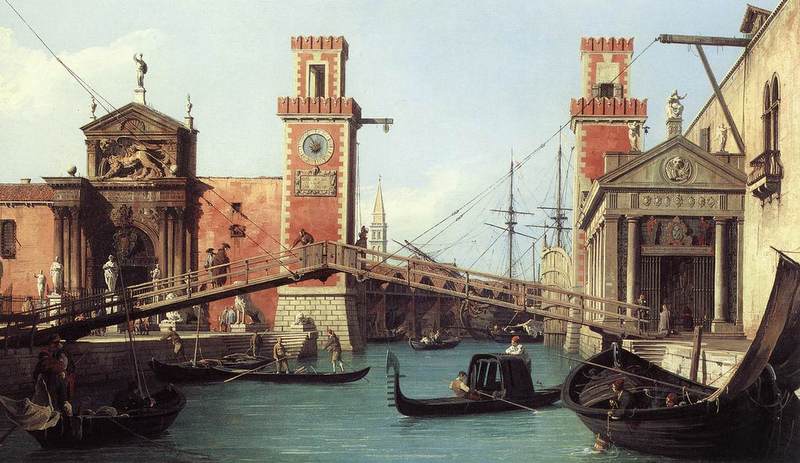 Venice – Castello
Venice – Castello
The CASTELLO border we have adopted runs to the northwest along the Rio di San Felice and Sacca della Misericordia, in the south-west along the canal, which starts at the post office in Rialto and ends at the back of San Marco, and to the east along the Rio dell'Arsenale and the Arsenal itself. It is a neighborhood, where you can feast your eyes on a variety of architecture, from delicate and sophisticated to blatant exaggeration (Santa Maria dei Miracoli the Jesuits), immerse yourself in the history and mythology of Venice (Saints John and Paul i Santa Maria Formosa), and walk one of the world's most picturesque boulevards, Riva degli Schiavoni.
North-west part
According to the official administrative division, the area north of Ca 'd'Oro belongs to the sestiere Cannaregio, but because Rio di San Felice and Canale della Misericordia represent a clear geographical range, putting it in Castello makes more sense. Near the northern border of this zone, Fondamente New, there is the church of Santa Maria Assunta, popularly known as Gesuiti (codz. 10.00-12.00 i 15.00-19.00). Jesuits began work on building this church in the year 1714. Fabrication of inlaid marble walls and carved marble 'curtains” it took 15 years, but the results delight even those, who do not like baroque architecture. On the first altar, on the left, there is a night scene of the Martyrdom and in. Lawrence Titian, the viewing of which is additionally difficult due to poor lighting.
Strada Nova runs closer to the Grand Canal, which was laid out in the years 1871-72 tearing down many houses. It is a busy shopping street, where you can buy practically anything, from spaghetti to dressings. More or less in the middle of this street, inconspicuous street Ca 'd'Oro goes to the side, which leads to the palace of the same name. It is a gothic edifice, changed to a large extent by restoration work, whose most interesting feature, facade, it is best seen from the water side (tooth. "Large channel” below). Inside Galleria Giorgio Franchetti (pn.-sb. 9.00-14.00; 2000L) consists of exhibits inscribed in the museum by Franchetti, who, as the owner of Ca 'd'Oro, renovated the palace in the early 20th century, and paintings from several state museums. One of the most valuable works is the head-shaped top of the well in the yard, carved by Bartolomeo Bona. There is also Saint Sebastian Mantegny and the beautifully carved young couple Tullio Lombardo. Great artists such as Tintoretto and Titian are also represented, but their best works are not here, so it is better to concentrate on the canvases of lesser known painters, though sometimes equally brilliant (it is worth looking at e.g.. on the landscapes View from the Piazzetta on San Giorgio and around the pier with a view of Salute Francesco Guardi).
At the eastern end of Strada Nova, Campo dei Santi Apostoli and the Church of Santi Apostoli are at the crossroads. It looks boring from the outside, but the interior is noteworthy for the Cappella Corner: the chapel was supposedly designed by Mauro Coducci, Communion and in. Lucia on the altar is by Giambattista Tiepolo, and the construction of Marco Corner's tomb (Caterina Cornaro's father; tooth. „Asolo”) credited to Tullio Lombardo.
Surroundings of Miracoli
The road from Santi Apostoli to one of the most beautiful buildings in Europe, Miracoli church full of works by the Lombardo family (Santa Maria dei Miracoli) is already relatively simple. The church was built in the 1780s as the sanctuary of the Madonna image, to whom he was credited with performing numerous miracles, m.in. resurrection of man, which for half an hour lay at the bottom of the Giudecca Canal. The Lombardo Floor is considered the author of the church design, but the proven fact is only that, that the artist and his two sons, Tullio i Antonio, they watched over the construction works and made many decorations. A typical feature of Venetian Renaissance architecture was the primacy of effect over fidelity to the classical style, and so e.g.. Corinthian pilasters were placed here under the Ionic ones, that the viewer from below may better appreciate the beauty of the former.
The marble-decorated interior contains some of the most elaborate carved decorations in Venice. Figures of two saints and the Annunciation scene on the balustrade of the gallery high above (at the eastern end of the church) are considered to be the work of Tullio Lombardo. The other sculptures found here are certainly the work of members of the Lombardo family, but we know nothing more. The children's heads, placed above the altar steps, made a very special impression on Ruskin: "someone, who was able to carve a child's head so perfectly, cut it off and attach it to the vine leaf with a bristle, he had to be devoid of all human feelings”.
Going from Miracola further towards Rialto we come across the intimate church of San Giovanni Crisostomo, built approx. 1500 year according to the design by Mauro Coduc-cie. It contains a wonderful canvas from the late period of Giovanni Bellini's work, St. Jerome, Christopher and Augustine and an excellent painting by Sebastiano del Piombo St.. Jan Chrysostom with i. John the Baptist. Liberal, Mary Magdalene, Agnieszka and Katarzyna. There is a tiny one at the back of the church, courtyard surrounded by old buildings, Second Court of the Million, at which there is, among others. Marco Polo's family home.